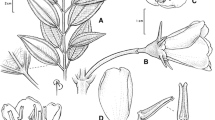Summary
Taxonomic studies of Brazilian Meriania species (Merianieae – Melastomataceae) have identified taxonomic and nomenclatural gaps. The present work proposes one new synonym, M. sanchezii, for M. paniculata; one new neotypification of M. glabra; and five lectotypifications for M. calophylla, M. glabra var. parviflora (= M. glabra), M. paniculata, M. pergamentacea (= M. robusta), and M. urceolata.
Similar content being viewed by others
References
Baumgratz, J. F. A. (2004). Sinopse do gênero Huberia DC. (Melastomataceae: Merianieae). Revista Brasil. Bot. 27: 545 – 561.
____ & Souza, M. L. D. R. (2005). Duas novas espécies de Leandra Raddi (Melastomataceae) para o Estado de São Paulo, Brasil. Acta Bot. Bras. 19: 573 – 578.
Chamisso, A. (1834). De plantis in expeditione speculatoria romanzoffiana et in herbariis regiis berolinensibus observatis. Melastomaceae americanae. Linnaea 9: 368 – 460.
Chiavegatto, B. & Baumgratz, J. F. A. (2008). Meriania (Melastomataceae; Merianieae) no Rio de Janeiro, Brasil. Rodriguésia 59: 899 – 912.
Candolle, A. P. De (1828). Prodromus Systematis Naturalis Regni Vegetabilis. Treuttel & Wurtz, Paris.
Cogniaux, A. (1886, 1888). Meriania. In: C. F. P. Martius, A. G. Eichler & M. Urban, Flora Brasiliensis 14(4): 23 – 33, 397 – 656. Frid. Fleischer, Monachii, Lipsiae.
____ (1891). Melastomaceae. In: A. Candolle & C. Candolle (eds), Monographiae Phanerogamarum 7: 1 – 1256. G. Masson, Paris.
Goldenberg, R. & Martins, A. B. (1999). Two new Melastomataceae from São Paulo, Brazil. Kew Bull. 54: 465 – 470.
____ & Amorim, A. M. (2006). Physeterostemon (Melastomataceae): a new genus and two new species from the Bahian Atlantic Forest, Brazil. Taxon 55: 965 – 972.
Luckana, N. G. & Berry, P. E. (2001). Meriania Sw. (Melastomataceae). In: P. E. Berry, K. Yatskievych & B. K. Holst (eds), Flora of Venezuelan Guayana, pp. 384 – 386. Missouri Botanical Garden Press, St. Louis.
McNeill, J., Barrie, F. R., Burdet, H. M., Demoulin, V., Hawksworth, D. L., Marhold, K., Nicolson, D. H., Prado, J., Silva, P. C., Skog, J. E., Wiersema, J. H. & Turland, N. J. (eds) (2006). International Code of Botanical Nomenclature (Vienna Code). Regnum Veg. 146.
Triana, J. (1871). Les Mélastomacées. Trans. Linn. Soc. London, Bot. 28: 1 – 188.
Wurdack, J. J. & Renner, S. (1993). 99. Melastomataceae: Melastomoideae. In: A. R. A. Görts-van Rijn (ed.), Flora of the Guianas Series A (13): 1 – 427. Koeltz Scientific Books, Koenigstein.
Acknowledgements
We wish to express our gratitude to the curators of the cited herbaria for making their collections available, to the anonymous reviewers for their suggestions, to CAPES and CNPq — Brazilian Research Council, for financial support to the first and second authors, respectively; FAPERJ for financial research support and to Dr Roy Funch for revising the manuscript in English.
Author information
Authors and Affiliations
Corresponding author
Rights and permissions
About this article
Cite this article
Chiavegatto, B., Baumgratz, J.F.A. Typification and synonymy of Meriania species (Merianieae – Melastomataceae) from Brazil. Kew Bull 66, 167–169 (2011). https://doi.org/10.1007/s12225-010-9224-1
Accepted:
Published:
Issue Date:
DOI: https://doi.org/10.1007/s12225-010-9224-1




